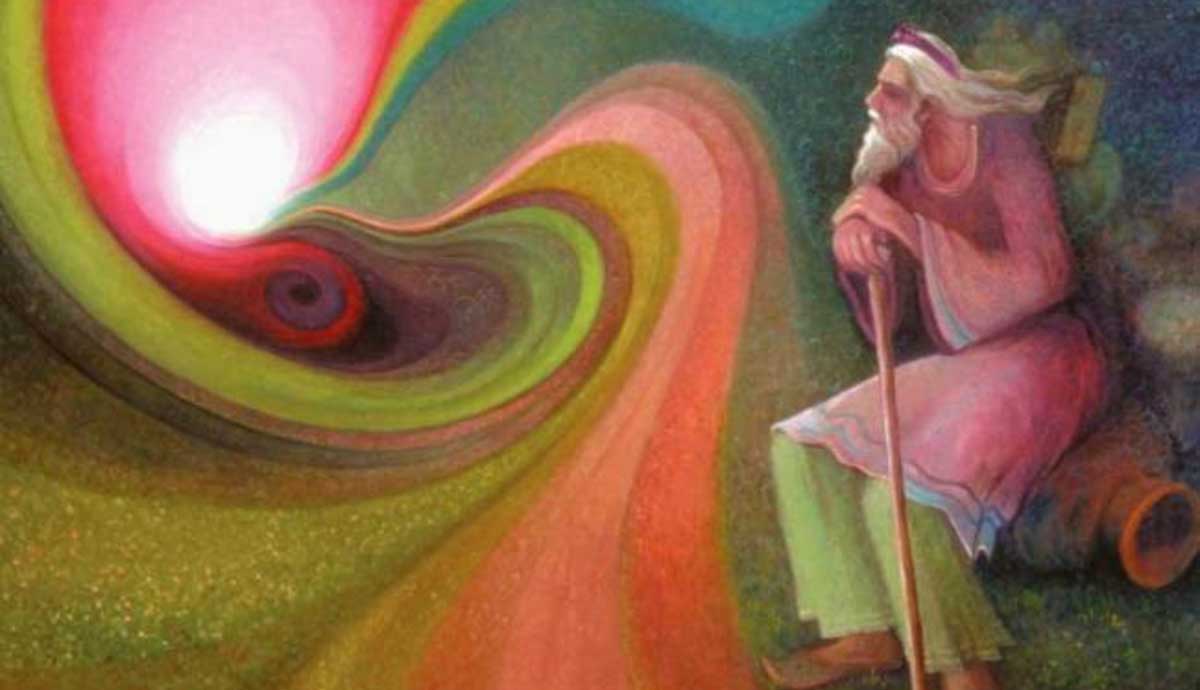
We’ve all heard at some point in our lives the claim made by many religions that God is one, but what does “God is one” mean? The history of philosophical discourse is concerned with questions related to God’s existence, and debates regarding what God is and what God is not. The 13th century Andalusian mystic and philosopher Muhyiddin Ibn Arabi devoted his life to the study of these issues. His works show that the dilemma lies not in the answers to these questions, but in the questions themselves.
Through the Unity of Being theory, Ibn Arabi presents us with a complete reformation of our ordinary perception of reality, knowledge, ontology, and much more. The heart of Ibn Arabi’s worldview lies in the aforementioned theory, which consists in a very profound answer to our first question regarding what it means to say that God is one. In this article, we will start our journey by exploring Ibn Arabi’s vision of God’s unity.
Ibn Arabi: The Greatest Master and the Blasphemous Heretic

Ibn Arabi is perhaps the most controversial figure in the history of Islamic thought. On one hand, he is revered as ‘the Greatest Master’ (Al-Shaykh Al-akbar) and is considered the prime spokesman of esoteric Islam. On the other hand, he is severely condemned by many with charges of heresy, unbelief, blasphemy, pantheism, and even atheism. His name remains very controversial to this day. How can one person trigger responses that contradict on such an extreme level? The answer lies in his Unity of Being theory (Wehdet al-Wujud).
Surprisingly, the term that became almost synonymous with Ibn Arabi’s name was never even mentioned by him in any of his works. In fact, even the discussion of the contents of what later came to be known as the Unity of Being was not the aim of Ibn Arabi in his works. Rather, his entire literary corpus is primarily concerned with what it means to be fully human. Ibn Arabi’s school of thought can be best described as one dealing with the potential of human perfection and the transformative path towards that realization. The term ‘Unity of Being’ was attributed to his school long after his death, in particular by Ibn Taymiyya, a revered theologian that severely criticized Ibn Arabi. Ibn Taymiyya’s interpretation of Ibn Arabi’s works turned his teachings into a special doctrine seemingly divorced from essential Islamic values. Ever since, the Unity of Being theory has been associated with autonomy and controversy.

Considering the term alone without imposing any interpretations upon it, there is nothing special or controversial in saying that Ibn Arabi believed in the Unity of Being. Being (Wujud) is a term denoting God, which will be further explained below. So, to say that Ibn Arabi believed in the unity of God is to say that he believed that God is one. There is nothing surprising or debatable about that considering that this belief is fundamental to any Abrahamic religion. It is the first article of faith in Islam, called tawhid, which is the belief and declaration of God’s unity. What is, however, unique about Ibn Arabi, is that his works shed light on the immensely profound meaning and implications of God’s unity.
Ibn Arabi and His Method

Ibn Arabi has had a tremendous influence on Islamic philosophy, but to call him a philosopher is slightly misleading. The term could perfectly describe him in the general and original sense of the word as a lover (philo) of wisdom (sophia). But if we take philosophy to mean the acquiring of wisdom through rational investigation only, then we cannot describe him as such. Ibn Arabi on many occasions recognizes the dire limitations of human reason, without, nevertheless, denying its importance.
Human reason depends on what can be called black or white logic. It is a logic that comprehends no contradiction, but rather proves its postulates by disproving their opposites. Human demonstrative reason cannot comprehend Ibn Arabi’s black and white knowledge, a knowledge that unifies opposites, much like the Yin and Yang principle in Eastern traditions. That does not mean, however, that Ibn Arabi condemned reason; rather, he finds it incapable of grasping a reality that transcends it, such as the reality of God. He does not arrive at the knowledge he presents to us in his works through rational means, but through a mystical epistemology that allows him to experience God’s unity, and not merely conceptualize it.

The complementary significance of rationality and mystical experience will be elaborated in more depth as we explore the Unity of Being theory. What is important to note so far is that a lot of meaning is lost when we attempt to translate non-discursive and non-conceptual mystical knowledge into theory, which is to say that explaining his very dense and metaphorical writings can never do justice to what Ibn Arabi intended to express, but can only take us closer to its meaning. The legacy of his works gives us a lantern to guide our understanding, but our understanding will always be lacking by definition so long as we have not tasted the metaphorical fruits of experience ourselves. Nevertheless, the journey is worth taking, for even if our theoretical explanations cannot perfect our understanding of his works, they certainly provide us with a wealth of insights that inevitably contribute to our intellectual evolution.
The Names of God

God in Islam is referred to as Allah. In Islamic scripture, the Quran, God is also referred to by many other names, such as the Merciful, the Forgiver, etc. These names are considered His qualities or attributes. Traditionally, there are 99 names known as the most beautiful names of Allah, but Ibn Arabi remarks that there are infinite Divine names. However, unlike any other name, Allah is considered the all-comprehensive name, meaning that it is the name that implies all names or attributes within itself. It is the only name that designates the entirety of God’s infinite and unlimited reality. There is no other Divine name that is all-comprehensive, because every other name denotes a certain aspect of the Divine reality and not its totality.
If Allah is the all-comprehensive name, what is named is the Divine Essence (that-Allah). The Divine Essence is considered the Ultimate Reality that is the original source of any other reality. It is God in Himself, independent from anything other than Himself. The only thing we can know about the Divine Essence is that we cannot know it. In this sense, only God knows God. However, Ibn Arabi contrasts the Divine Essence and the Divine names or attributes, which can be known to some extent whenever God assumes relationships with anything other than Himself. Since he defines the cosmos as “everything other than God” (ma siwa Allah), Ibn Arabi contends that the attributes are knowable to a certain extent whenever God is considered in relation to the cosmos. It is through God’s relation to the cosmos as creator that we come to know His name the Creator (al-khaleq) for example.
Without considering the cosmos, there is no distinction whatsoever between the Divine Essence and the Divine names. The attributes cannot be known because they are undifferentiated within the Divine Essence. The infinite Divine Names are one with the Divine Essence, they are ontologically one and the same. In this way, we consider the Divine Essence with all its names or attributes non-manifest.

To clarify, let’s consider the analogy of physical light. Light in itself is invisible, yet when some of it is absorbed by the darkness of objects, we see it reflected as many beautiful colors. Without darkness, which is other than light, we can say that these beautiful colors are only latent qualities of light. The colors are non-manifest within what we can call pure light, unsullied by darkness, and they cannot be differentiated from one another.
Likewise, the Divine names can be considered latent qualities of the Divine Essence that cannot be differentiated from one another. The ‘Forgiver’ is the same as the ‘Omniscient’, and the ‘Omnipotent’ is the same as the ‘Merciful’, and all Divine names are the infinite singular unity of the Divine Essence. In a similar sense red is the same as blue, and green is the same as yellow, and all colors are the same because they are undifferentiated as a unity of pure light. Moreover, many Divine names can be seen as mutual opposites, such as the ‘Merciful’ and the ‘Wrathful’, but they are all united within God’s reality as the singular Divine Essence. In the same way, there are diverse mutually opposite colors such as red and green that cancel each other out. When all these colors are latent in pure light, all opposites are unified. For this reason, Ibn Arabi often remarks that God is the great unifier of opposites.
Just like the plurality of colors latent in pure light does not entail ontological plurality, the infinite plurality of the attributes of the Divine Essence does not entail that there are several Divine Essences or that the Essence is a compound of many parts. Because the attributes are absolutely undifferentiated within it, they are identical to the Divine Essence. To make it simple, the ontological unity of the Divine Essence is basically the unity of ‘God’s Being’. That is what is meant when we say God is one.
The Ontological Unity of Being

Understanding God’s unity in relation to ontology is slightly confusing though. When we say God is one in ‘His Being’ we immediately assume entification, meaning that we assume thinghood. We assume that the statement means there is only one entity that is ‘up there’. We assume that God is an entity or a thing that is qualified by being or existence, but this is a huge misunderstanding. An entity, or a thing, is by definition limited, for in order to be itself, it needs to be differentiated vis a vis something else.
Limitations are a necessary property of thinghood, because without the particular limits that make a thing itself and not something else, we would not be able to define it. There are distinct confinements that make us see a tree as a tree and not as an elephant, for example. These specific limitations pertaining to entities or things are called their quiddities, meaning their ‘whatness’. Through quiddity we can define and know what things are.

But God is infinite, unlimited, and there is no differentiation whatsoever in His Essence. So, when we say God is one, we cannot understand that to mean that God is one thing. He is not an entity or a thing that we can define or know by the specific limitations of its quiddity. He has no whatness, which is precisely why the Divine Essence in itself cannot be defined or known. So, to ask ‘what is God?’ is to misunderstand His Essence. This question through which we try to understand God actually hinders our understanding, because we cannot ask it without presupposing that God is limited. So is the case when we ponder whether or not God exists, for the question already presupposes thinghood and, thus, limitation. God is not a thing or an entity that exists or doesn’t exist. The question presupposes a definition, an answer to the previous question regarding God’s whatness, based on which we can ask whether it exists or not. All these questions are futile when we stop viewing God as an entity or a thing.

In the history of Islamic philosophy, quiddity has often been contrasted with wujud, which can be translated as existence or being itself. There are two questions that can be asked about a given object: ‘is it?’ and ‘what is it?’. The first question refers to that object’s existence, whereas the second refers to its quiddity. Although we can precisely define a thing’s quiddity, we cannot define its existence. We usually only talk about existence in reference to an object or a thing, but can we ask what is existence in itself without connecting it to a certain object or thing that is qualified by it? Take a moment and try thinking of existence without referring to any quiddity. It’s impossible! Existence or being itself cannot be defined, only things can be defined. Considered by itself, existence has no quiddity by which we can define or conceive of it.
Given that we just explained that God in His Essence has no quiddity, Ibn Arabi contends that God is not a thing or an entity that we can say exists or does not exist, but He is existence itself, pure Wujud. If God is Wujud, how can we speak of any ontological plurality? It is logically impossible to conceive that there are two or more Wujuds, for what is other than existence itself but non-existence (i.e. unreality)? Wujud is one in that sense, and it is in that sense that polytheism is impossible.
If we think of several Gods, we cannot be thinking of them as pure Wujud, for in order to conceive of their ontological plurality we presuppose their quiddity (i.e. entification or thinghood). This is the meaning of the unity of Being (wehdet al-wujud) and the meaning of the statement ‘God is one’. It is also why God, understood as existence in itself, is considered the ultimate ground of reality, for God is the ontological source of any reality we conceive of.

There is a linguistic challenge when we explain this in the English language and for this reason I will recourse to Arabic terms. As we said, wujud is a word in Arabic that designates existence itself. Mawjud, on the other hand, is a word that refers to a thing or an entity’s existence. It is derived from the word wujud, and the word itself literally denotes that the thing or entity in question is ‘given’, or has been qualified by, existence. Hence, through these words there is a less confusing distinction between existence itself and the existence of an entity or a thing. To maintain this distinction in mind, I will henceforth refrain from translating wujud.
The clarity of this distinction is not, however, the only reason why we should generally refrain from translating Wujud. The issue lies in the richer meaning of the word Wujud that words like “existence” or “being” do not capture. In the history of Western philosophy, consciousness and awareness are usually considered as accidental phenomena that somehow emerged in the course of the cosmos’ existence. The word ‘existence’ does not imply consciousness, awareness, or knowledge. We are accustomed to thinking that intelligence somehow popped out of a dead and stupid universe.
Such is not the case, however, in the meaning of the Arabic word wujud. Wujud does not only mean pure existence, but it also means finding and being found, a meaning that we would explore later in this article. It can also be translated as presence and the word etymologically shares the root of the words wijdan and wajd. Wijdan means consciousness, awareness, and love, whereas wajd means ecstasy. So, in Arabic we cannot consider existence without divorcing it from consciousness, awareness, knowledge, and love, among other meanings.
Only God Knows God

So far, we said that the Divine Essence is pure non-delimited Wujud where all Divine attributes (i.e. names) are undifferentiated like colors latent in pure invisible light. Most importantly, we explained that Wujud is one, since what can there be other than existence in itself but non-existence (unreality)? We cannot make any positive knowledge claims about God. In His Essence, God cannot be known in any positive way. We can only know His Essence by negating what it is not, just like we said that He cannot be a quiddity for example. When considering the utter transcendence of God’s Essence, Ibn Arabi often quotes the Quranic verse (42:11): “there is not anything like Him”. In that sense, Ibn Arabi often remarks that only God knows God.
We may inevitably ponder at this point of our discussion several questions. For example, how did we come to know that God has attributes such as Creator if all of His attributes are unknowable and undifferentiated in His Essence? Furthermore, if God is pure Wujud, how should we understand our own sense of existence and consciousness in relation to Him? These are all very profound questions that we will address in this article, which I believe are grounded in Ibn Arabi’s understanding of God’s knowledge.

Ibn Arabi remarks that God’s non-delimitation is absolute, which is why it cannot prevent Him from delimitation. If God’s non-delimitation prevents Him from delimitation, He would be limited by the constraints of His own unlimitedness, and He will not actually be unlimited. Wujud is unlimited in an absolute sense, allowing Him to assume all limitations without being constrained by these limitations. As Ibn Arabi notes, “God possesses Nondelimited Wujud, but no delimitation prevents Him from delimitation…on the contrary, He possesses all delimitations, so He is nondelimited delimitation” (Ibn Arabi, 1911). These delimitations represent the infinite possibilities whereby non-delimited Wujud can manifest its attributes. They can be understood in our analogy as the many possibilities of the manifestation of colors that are latent or hidden in pure invisible light. These infinite possibilities are the objects of God’s knowledge of Himself.
The colors latent in pure light are undifferentiated and, thus, non-manifest so long as light is not absorbed by darkness. Without darkness, we cannot see any specific color. When we look at a purple paper, we see the color because the ‘un-purple’ part of the visible light spectrum is absorbed in the paper. The colors hidden in invisible light can only be seen by that which is other than light, which is darkness. Likewise, the attributes undifferentiated and hidden in Wujud can only be manifested by that which is other than Wujud, which is non-existence (unreality). Only when Wujud is considered vis-à-vis non-existence can its attributes become differentiated and known, just like only when light is considered along with darkness can its colors become differentiated and seen.
What Is Non-Existence?

Non-existence, unreality, and darkness cannot be conceived of in positive terms in and of themselves. By definition, non-existence, unreality, and darkness, are the absence of existence, reality, and light respectively. The differentiation of the attributes (i.e. the names) happens when the radiance of Wujud is dimmed by specific possibilities of non-existence that allows “existence in certain distinct modes that exclude the possibility of simultaneous existence in other distinct modes” (Murata, 1992). Such is how the name ‘the Merciful’ becomes differentiated from ‘the Just’ for example, and how ‘red’ becomes differentiated from ‘purple’ in our analogy. These specific modes of non-existence are synonymous to quiddities, and through them the hidden attributes of the Divine Essence can be manifested. Likewise, light manifests its colors through specific modes of darkness.
We must, however, always keep in mind that pure non-delimited Wujud is necessary, whereas the self-delimitations of Wujud by non-existence are only possibilities. Ibn Arabi reminds us that the attributes cannot be considered as concrete things, but as mere relations. Indeed, although colors are seen via specific modes of darkness, they are properties of light not of darkness. We cannot consider them concretely, independently from light. Furthermore, the quiddities, or the specific limitations, that differentiate the attributes of Wujud do not pertain to Wujud itself, but to non-existence.
Similarly, the degree of darkness that absorbs light, allowing colors to be differentiated and seen, are not properties of light itself but of darkness. Light is not darkness, and Wujud is not non-existence. So, the attributes themselves are not limited within Wujud, just like colors are not limited within pure light. They can only be understood as specific attributes when Wujud is related to non-existence in God’s knowledge of the infinite possibilities of manifestation inherent in His essence.
In the next part of this article, we will explore the mysterious relationship of God’s ontological unity, and the plurality of his objects of knowledge in relation to creation and our ordinary perception of reality. Through it, we will gain a profound understanding of the fundamental nature of reality, which will be the ground for our future explorations of the extraordinary world of Ibn Arabi.










